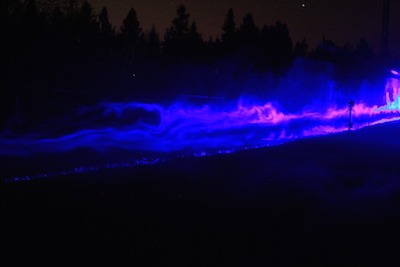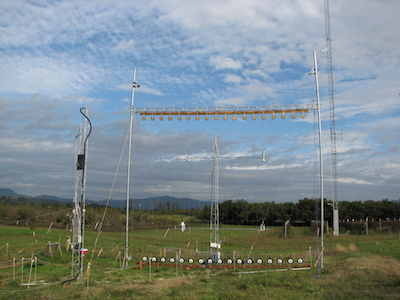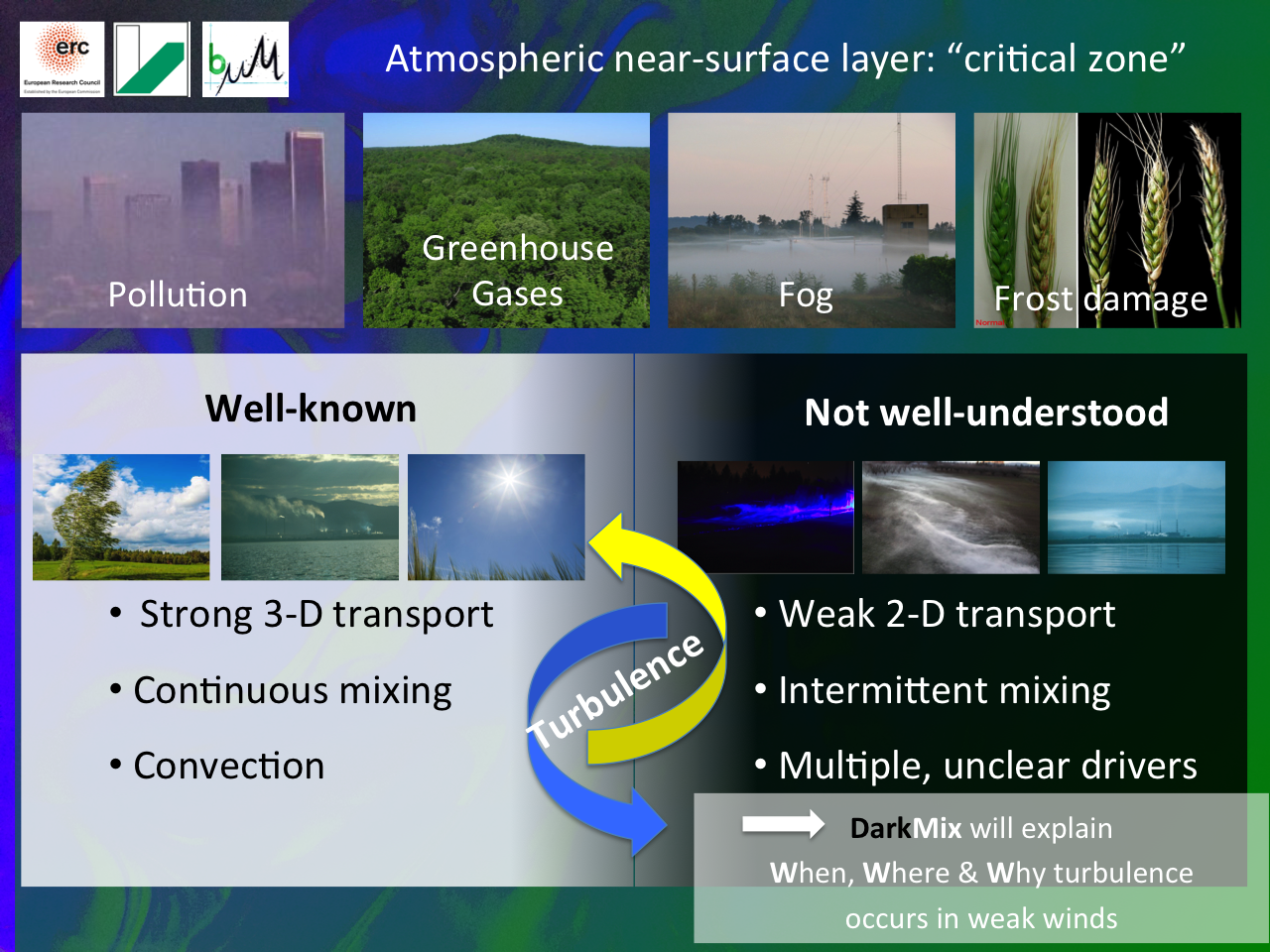Illuminating the dark side of surface meteorology: creating a novel framework to explain atmospheric transport and turbulent mixing in the weak-wind boundary layer
ERC DarkMix
From 05/2017 to 01/2023Principal Investigator: Christoph Thomas
Staff: Karl Lapo, Shravan Kumar Muppa, Anita Freundorfer, Lena Pfister, Mohammad Abdoli, Johann Schneider, Jannis Huss
 Surface meteorology impacts the abundance and quality of life on Earth through the transfer and mixing of light, heat, water, CO2, and other substances controlling the resources for humans, plants, and animals. However, current theories and models fail when airflows and turbulence are weak during calm nights leaving weather and climate forecasts uncertain. This ‘dark side’ occupies substantial fractions of time and our landscape, its physics are largely unknown, and has eluded proper experimental investigation.
Surface meteorology impacts the abundance and quality of life on Earth through the transfer and mixing of light, heat, water, CO2, and other substances controlling the resources for humans, plants, and animals. However, current theories and models fail when airflows and turbulence are weak during calm nights leaving weather and climate forecasts uncertain. This ‘dark side’ occupies substantial fractions of time and our landscape, its physics are largely unknown, and has eluded proper experimental investigation.
DarkMix creates technological and theoretical innovations to observe and explain transport and mixing in the weak-wind boundary layer. Its ambitious goal is a radically new framework incorporating unexplored mechanisms such as submeso-scale motions, flow instationarities, and directional shear to effect a quantum leap in understanding the air-plant-soil exchange. DarkMix will build the ground-breaking first-ever fiber-optic distributed temperature sensing harp to fully resolve the 3-dimensional flow and air temperature fields and enable unprecedented computation of eddy covariance fluxes at scales of seconds over 4 orders of magnitude (deci- to hundreds of meters). Both key innovations bear significant risks of technical and fundamental nature, which are mitigated by pursuing alternatives. Measurements will inform cutting-edge large eddy simulations to test hypotheses. The interdisciplinary dimension takes DarkMix to a unique set of weak-wind sites including a valley-bottom grassland, a forest in complex terrain, and a city to investigate topographic effects, the forest carbon cycle, and the urban heat island.
explain transport and mixing in the weak-wind boundary layer. Its ambitious goal is a radically new framework incorporating unexplored mechanisms such as submeso-scale motions, flow instationarities, and directional shear to effect a quantum leap in understanding the air-plant-soil exchange. DarkMix will build the ground-breaking first-ever fiber-optic distributed temperature sensing harp to fully resolve the 3-dimensional flow and air temperature fields and enable unprecedented computation of eddy covariance fluxes at scales of seconds over 4 orders of magnitude (deci- to hundreds of meters). Both key innovations bear significant risks of technical and fundamental nature, which are mitigated by pursuing alternatives. Measurements will inform cutting-edge large eddy simulations to test hypotheses. The interdisciplinary dimension takes DarkMix to a unique set of weak-wind sites including a valley-bottom grassland, a forest in complex terrain, and a city to investigate topographic effects, the forest carbon cycle, and the urban heat island.
DarkMix will open a new window for surface meteorology and its links to air quality, biogeochemistry, and climate change by giving physically meaningful and societally relevant answers to profound questions such as the exchange of greenhouse gases, hazards from ground fog, urban pollution, and agricultural losses through extreme cold air.

List of publications of this Project
| Peltola, O; Lapo, K; Martinkauppi, I; O`Connor, E; Thomas, CK; Vesala, T: Suitability of fiber-optic distributed temperature sensing to reveal, Atmospheric Measurement Techniques Discussions, 2020, 1-31 (2020), doi:10.5194/amt-2020-260 |
| Mahrt, L; Pfister, L; Thomas, CK: Small-Scale Variability in the Nocturnal Boundary Layer, Boundary-Layer Meteorology, 174(1), 81-98 (2020), doi:10.1007/s10546-019-00476-x |
| Vogl, T; Hrdina, A; Thomas, CK: Choosing an Optimal β Factor for Relaxed Eddy Accumulation, Biogeosciences Discussions, 2020, 1-26 (2020), doi:10.5194/bg-2020-445 |
| Freundorfer, A; Rehberg, I; Law, BE; Thomas, CK: Forest wind regimes and their implications on cross-canopy coupling, Agricultural and Forest Meteorology, 279, 107696 (2019), doi:10.1016/j.agrformet.2019.107696 |
| Pfister, L; Lapo, K; Sayde, C; Selker, JS; Mahrt, L; Thomas, CK: Classifying the nocturnal atmospheric boundary layer into temperature and flow regimes, Quarterly Journal of the Royal Meteorological Society (2019), doi:10.1002/qj.3508 |
| Lapo, K; Freundorfer, A; Pfister, L; Schneider, J; Selker, JS; Thomas, CK: Distributed observations of wind direction using microstructures attached to actively heated fiber-optic cables, Atmospheric Measurement Techniques Discussions, 2019, 1--17 (2019), doi:10.5194/amt-2019-188 |
| Sigmund, A; Pfister, L; Sayde, C; Thomas, CK: Quantitative analysis of the radiation error for aerial coiled fiber-optic Distributed Temperature Sensing deployments using reinforcing fabric as support structure, Atmospheric Measurement Techniques Discussions, 2016, 1-26 (2016), doi:10.5194/amt-2016-266 |
| Mahrt, L; Thomas, CK: Surface stress with non-stationary weak winds and stable stratification, Boundary-Layer Meteorology, 159, 3-21 (2016), doi:10.1007/s10546-015-0111-z |
| Sayde, C; Thomas, CK; Wagner, J; Selker, JS: High-resolution wind speed measurements using actively heated fiber optics, Geophysical Research Letters, 42(22), 10,064–10,073 (2015), doi:10.1002/2015GL066729 [Link] |
| Vickers, D; Thomas, CK: Observations of the scale-dependent turbulence and evaluation of the flux--gradient relationship for sensible heat for a closed Douglas-fir canopy in very weak wind conditions, Atmospheric Chemistry and Physics, 14(18), 9665-9676 (2014), doi:10.5194/acp-14-9665-2014 |
| Zeeman, MJ; Selker, JS; Thomas, CK: Near-surface motion in the nocturnal, stable boundary layer observed with fibre-optic distributed temperature sensing, Boundary-Layer Meterology, 154(2), 189-205 (2014), doi:10.1007/s10546-014-9972-9 |
| Thomas, CK; Kennedy, AM; Selker, JS; Moretti, A; Schroth, MH; Smoot, AR; Tufillaro, NB; Zeeman, MJ: High-resolution fibre-optic temperature sensing: A new tool to study the two-dimensional structure of atmospheric surface layer flow, Boundary-Layer Meteorology, 142, 177-192 (2012), doi:10.1007/s10546-011-9672-7 |
| Thomas, CK: Variability of subcanopy flow, temperature, and horizontal advection in moderately complex terrain, Boundary-Layer Meteorology, 139, 61-81 (2011), doi:10.1007/s10546-010-9578-9 |

